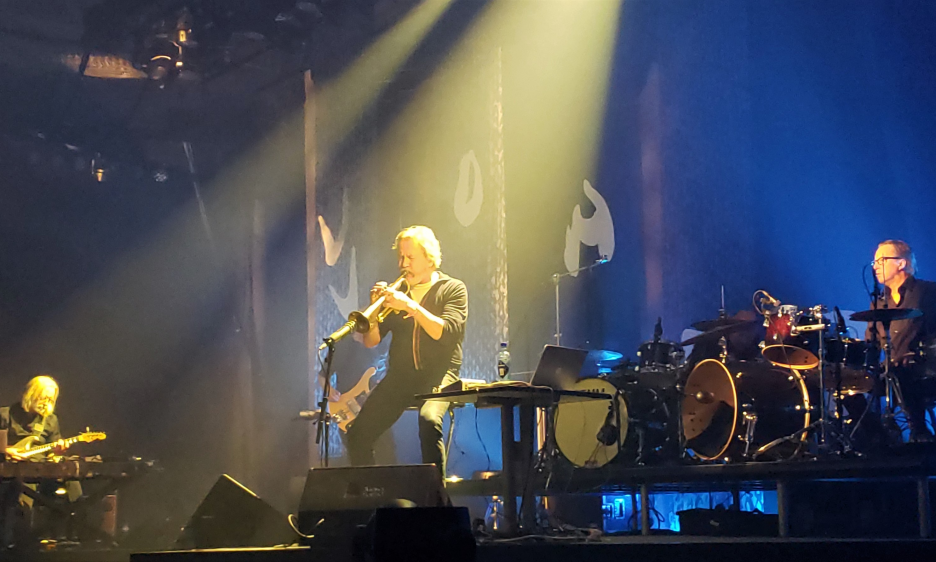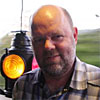Home » Jazz Articles » Live Review » Vossa Jazz Going Strong and Poetic at 50
Vossa Jazz Going Strong and Poetic at 50

Courtesy Josef Woodard
By this point (at 50), the Vossa Jazz festival is going strong, drawing large crowds and affirming its reputation as a go- to spot to hear some of the finest artists in the hearty Norwegian jazz scene... Given the milestone year and attendant waves of nostalgia, the program consciously reprised historical moments while embracing the evolving moment.
Voss, Norway
March 31-April 2, 2023
Origin stories in the still-young-ish wild frontier of jazz festival culture can be fascinating case studies in feisty pioneer spirit. Take the Western Norwegian Vossa Jazz Festival, an important stop in the storied Norwegian festival circuit, which celebrated its ripe old 50th birthday this year. Its humble origins date back to the dreaming and scheming of twentysomething jazz enthusiasts from Voss, Lars Mossefinn, Arild Wærness and Asle Haaland, who had first channeled their jazz passion into forming a local jazz club. After visiting the Montreux festival in Switzerland, they had a light-bulb moment: just as Montreux is a tourist destination on a lake, Lake Geneva, Voss was a beautiful small town renowned for skiing and other sports, on also on a lake, albeit the more modestly-scaled Voss Lake. Voila, the seed of a great festival in an intimate setting was born.
Circa 2023, the festival is now deep into a long chapter of renovation and re-galvanized identity, thanks to the guidance of the indomitable and charming director Trude Storheim. Storheim took the helm in 2017, following a downturn in the festival's fates which found the organization near bankruptcy. By this point, the festival is going strong, drawing large crowds and affirming its reputation as a go-to spot to hear some of the finest artists in the hearty Norwegian jazz scene. This year, the springtime ritual featured a stronger than usual list of Nordic luminaries, including Nils Petter Molvaer, Mathias Eick, Trygve Seim, enchanting folk-cum-jazz vocalist Sinekka Langeland, Paal Nilssen-Love's Large Unit , Mats Gustafsson's fiery The End, and a newish name worth watching, Oddrun Lilja, among others.
Other shows of note and otherwise memory-clingers this year included the rousingly fine Roma-meets-Nordic project Angrusori, featuring the irrepressible Iva Bittova, the cerebral and improv-structural wonder of the Danish piano trio of Soren Kjaergaard, bassist Jonas Westergaard and drummer Peter Bruun, and the epic Norwegian folk extravaganza of the "Landslaget for Spelemenn." That arena spectacular came equipped with custom jerseys, also sported by director Storheim. In one case of retracing Vossa Jazz history, the larger events this year settled into the sports arena Voss idrettshall, which hadn't been used since the pre-Storheim era. And did we mention Saturday night's ceremonial sheepshead dinner? More on that later.
Given the milestone year and attendant waves of nostalgia, the program consciously reprised historical moments while embracing the evolving moment. This was particularly true in terms of its well-known commissioning program, and the annual high-profile Tingingverket commissioning tradition. As a way of highlighting the impressive lineage of custom-made Tingingverket projects over the decades, we heard highlight examples of this special evening-long commission lineage. From 1990, noted bassist Arild Anderson's Sagn ("legend") ushered back into the present his score's venturesome mash-up of folk, jazz and fusion elements. Yet more significant was Molvaer's widely acclaimed Khmer, originally entitled Labyrinter and premiered in Voss back in 1996, with a globally popular and influential release on ECM two years later.
Proudly presented as the opening event of festival @ 50, Khmer managed the feat of being a first-and-best case scenario of the fest. Khmer was, and remains, a landmark in a personalized type of electro-cosmic jazz rising out of the ashes of fusion and reconsidering '70s electric voodoo Miles music with Nordic atmospheres in the ever-shifting margins. Despite its '90s vintage, the music translates powerfully to the modern day and the modern ear, enhanced by huge advances in digital music technology, expanding textual palettes. Electronician and live sampler Jan Bang (head of the venturesome Norwegian Punkt Festival) added fresh and malleable dimensionality to the material. Even so, the primal power of drums, via two strong drummers, and the sudden clarity and wistfulness of Molvaer's pure trumpet sound—in accord with guitarist Eivind Aarset's painterly sonics—are critical to the sum effect. Molvaer manages to balance the visceral tough guy persona with the air of a romantic melancholic.
Later that Friday night, over in the multi-stage and lakeside Park Hotel compound, various permutations of rhythmic and sonic convergences challenged the senses. The Large Unit's playfully elastic title aptly captures drummer-leader Nilssen-Love's ensemble scale, interweaving of raucous free play and structures, not to mention ironic suggestions of machinery and sex. Here, though, we caught the Unit in its "EthioBraz" mode, in taut collusion with the powerful Ethiopian music/dance group Fendika!, Nilssen-Love appeared at Vossa Jazz last year, in part, as a late-night DJ, with a strongly African playlist. With the EthioBraz project, the synthesis of Norwegian out-leaning jazz and Ethiopian seductions made for a cathartic furnace of positive cross-cultural energy. At midnight in the tight club quarters of the Park Pentagon, it was high time for/with The End. Headbanger jazz doesn't get much more potent or sternum-rattling than with the sound force of this fascinating, feverish but also musicality-blessed unit, charged by the twin reckoning force of bari saxophonist Gustafsson and tenor saxophonist Kjetil Møster, plus Swedish avant-vocal phenom Sofia Jernberg.
Female vocalists always have a strong place in Vossa Jazz programming, and this year's selection was notably and happily diverse. Popular pop singer Stephane Brunello closed the fest in the arena big house, while in the intimate venue of the Osasalen (in Voss' widely-respected Ole Bull Folk Music School), Langeland's poetic and altogether moving early afternoon set was the festival's most prime example of the natural Norwegian tendency for fluidly blending its deep folk tradition with jazz elements. While she held down the epicenter, as vocalist and player of the zither-like Finnish kantele, her work was deftly tethered to contributions from a stellar band—saxophonist Trygme Seim in his yearningly lyrical mode, trumpeter Eick waxing melodic and a flexible rhythm section of bassist Mats Eilertsen and drummer Thomas Strønen.
A rare American presence this year came in the form of the underrated wonder that is Martha Wainwright, who, although with little-or-no direct connection to jazz, per se, registered mightily on the pure terms of artistic expression and dramatic stage presence. The stage in question: the mystical space of the city's 13th century church, the Vangskyrkja. As for her own historical backdrop, we sense the deep familial musical roots of her parents—Kate McGarrigle and Loudon Wainwright III—and brother Rufus Wainwright, flavored with her own artistic voice, tinged by punk and punch, and a salty tenderness, as on her memorable cover of Tom Waits' "Take it With Me."
Jazz met and got along with pop elements in other important corners of the program. Intriguing and genre-fluid singer-songwriter Mariam Wallentin dazzled in unexpected ways and with a musical essence all her own, expanded into arrangements for the nine-piece group of fine Western Norwegian musicians, dubbed the Vestnorsk Jazzensemble. Echoes of such mold-breaking vocalist outliers as Annette Peacock and Adrianne Lenker trickled through Wallentin's set, but more importantly, she has a sound and a potential all her own. She's one to watch out for. The same could be said of this year's recipient of this year's Tingingverket offering. With her 75-minute commissioned work, young guitarist-composer Oddrun Lilja staked out her musical turf as a nimble and fresh-voiced instrumentalist, issuing tasteful and non-histrionic lines and solos sometimes reminiscent of Gabor Szabo and Larry Carlton (with her supple, toasty-distorted Gibson 335 sound in tow). But vocals played a strong role in the suite, courtesy of bold guest singer Beate Lech and a pair of background vocalists, variously evoking the jazz-ical intricacy of the Swingle Singers, Modern Jazz Quartet and quirky but heartfelt pop, including a late-breaking pop song in 11/4. It all came together with a surprisingly fluency and cohesion—parts of a restless musical soul adding up to an easily expressive whole.
Enter the Sheepshead Moment. After each year's Tingingverket event, a selective crowd of VIPs, toasted artists and stray-dog journalists gather for the ceremonial Hardanger region-specific smalahove dinner, consisting of a half a boiled sheep's head on a plate. The animal's intact eyeball seems to stare at the diner, both in challenge and—we think, hopefully—in appreciation for not letting this sacrificed creature's otherwise discarded parts go to waste. We—the partakers, at least—savor the fare and throw back a thimble of aquavit after bellowing "skål!"
At this milestone 50th anniversary affair, the collective sense of skål in this town felt especially hearty and well-deserved.
Tags
Festivals Talking
Nils Petter Molvaer
Josef Woodard
Norway
Trude Storheim
Matthias Eik
Trygve Seim
Sinekka Langeland
Paal Nilssen-Love's Large Unit
Mats Gustafson's
The End
Oddrun Lilja
Angrusori
Iva Bittova
Søren Kjærgaard
Jonas Westergaard
Peter Bruun
Arild Anderson's
Jan Bang
Eivind Aarset's
Fendika!
Kjetil Møster
Sofia Jernberg
Ane Brun
Mats Eilertson
Thomas Strønen
Martha Wainwright
Kate McGarrigle
Loudon Wainwright III
Rufus Wainwright
Tom Waits'
Mariam Wallentin
Annette Peacock
Adrienne Lenker
Gabor Szabo
Larry Carlton
MJQ
PREVIOUS / NEXT
Support All About Jazz
 All About Jazz has been a pillar of jazz since 1995, championing it as an art form and, more importantly, supporting the musicians who make it. Our enduring commitment has made "AAJ" one of the most culturally important websites of its kind, read by hundreds of thousands of fans, musicians and industry figures every month.
All About Jazz has been a pillar of jazz since 1995, championing it as an art form and, more importantly, supporting the musicians who make it. Our enduring commitment has made "AAJ" one of the most culturally important websites of its kind, read by hundreds of thousands of fans, musicians and industry figures every month.





















